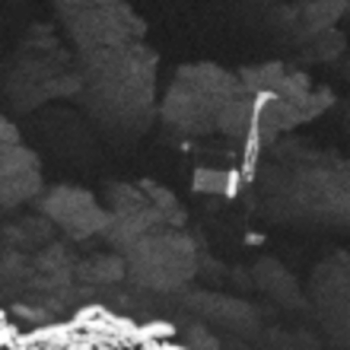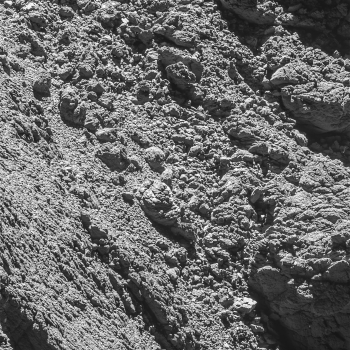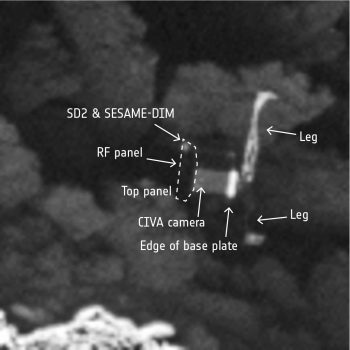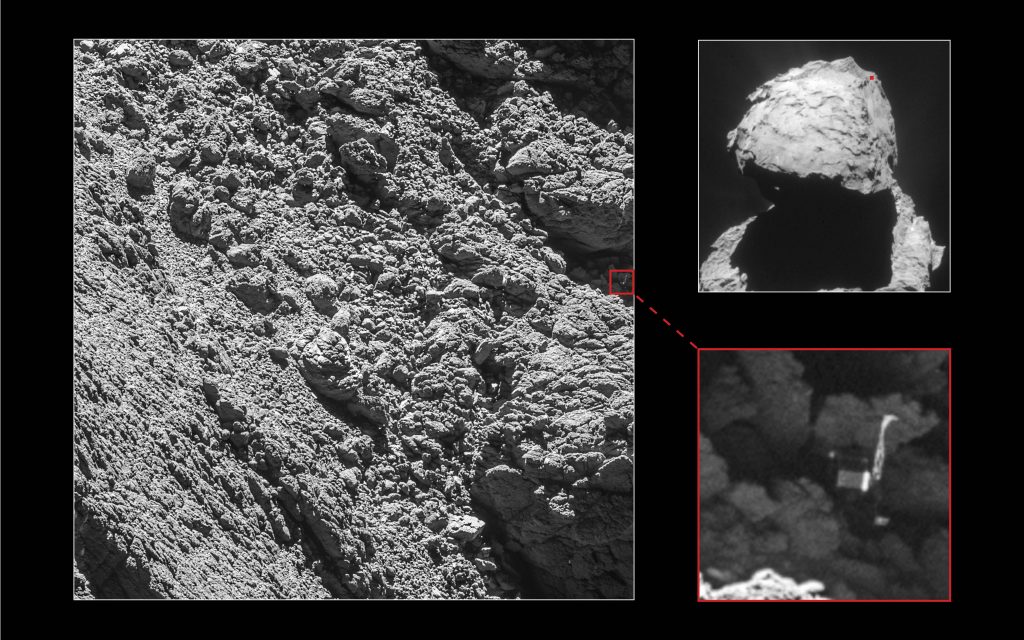Less than a month before the end of the mission, Rosetta’s high-resolution camera has revealed the Philae lander wedged into a dark crack on Comet 67P/Churyumov–Gerasimenko.
The images were taken on 2 September by the OSIRIS narrow-angle camera as the orbiter came within 2.7 km of the surface and clearly show the main body of the lander, along with two of its three legs.
The images also provide proof of Philae’s orientation, making it clear why establishing communications was so difficult following its landing on 12 November 2014.

Close-up of the Philae lander, imaged by Rosetta’s OSIRIS narrow-angle camera on 2 September 2016 from a distance of 2.7 km. The image scale is about 5 cm/pixel. Philae’s 1 m-wide body and two of its three legs can be seen extended from the body. The images also provide proof of Philae’s orientation.
The image is a zoom from a wider-scene, and has been interpolated.
Credits: ESA/Rosetta/MPS for OSIRIS Team MPS/UPD/LAM/IAA/SSO/INTA/UPM/DASP/IDA
“With only a month left of the Rosetta mission, we are so happy to have finally imaged Philae, and to see it in such amazing detail,” says Cecilia Tubiana of the OSIRIS camera team, the first person to see the images when they were downlinked from Rosetta yesterday.
“After months of work, with the focus and the evidence pointing more and more to this lander candidate, I’m very excited and thrilled that we finally have this all-important picture of Philae sitting in Abydos,” says ESA’s Laurence O’Rourke, who has been coordinating the search efforts over the last months at ESA, with the OSIRIS and SONC/CNES teams.
Philae was last seen when it first touched down at Agilkia, bounced and then flew for another two hours before ending up at a location later named Abydos, on the comet’s smaller lobe.
After three days, Philae’s primary battery was exhausted and the lander went into hibernation, only to wake up again and communicate briefly with Rosetta in June and July 2015 as the comet came closer to the Sun and more power was available.

An OSIRIS narrow-angle camera image taken on 2 September 2016 from a distance of 2.7 km in which Philae was definitively identified. The image has been processed to adjust the dynamic range in order to see Philae while maintaining the details of the comet’s surface. Philae is located at the far right of the image, just above centre. The image scale is about 5 cm/pixel. Credits: ESA/Rosetta/MPS for OSIRIS Team MPS/UPD/LAM/IAA/SSO/INTA/UPM/DASP/IDA
However, until today, the precise location was not known. Radio ranging data tied its location down to an area spanning a few tens of metres, but a number of potential candidate objects identified in relatively low-resolution images taken from larger distances could not be analysed in detail until recently.
While most candidates could be discarded from analysis of the imagery and other techniques, evidence continued to build towards one particular target, which is now confirmed in images taken unprecedentedly close to the surface of the comet.
At 2.7 km, the resolution of the OSIRIS narrow-angle camera is about 5 cm/pixel, sufficient to reveal characteristic features of Philae’s 1 m-sized body and its legs, as seen in these definitive pictures.
“This remarkable discovery comes at the end of a long, painstaking search,” says Patrick Martin, ESA’s Rosetta Mission Manager. “We were beginning to think that Philae would remain lost forever. It is incredible we have captured this at the final hour.”
“This wonderful news means that we now have the missing ‘ground-truth’ information needed to put Philae’s three days of science into proper context, now that we know where that ground actually is!” says Matt Taylor, ESA’s Rosetta project scientist.

A number of Philae’s features can be made out in this image taken by Rosetta’s OSIRIS narrow-angle camera image on 2 September 2016, including one of the CIVA panoramic imaging cameras, the SD2 drill and SESAME-DIM (Surface Electric Sounding and Acoustic Monitoring Experiment Dust Impact Monitor). Credits: ESA/Rosetta/MPS for OSIRIS Team MPS/UPD/LAM/IAA/SSO/INTA/UPM/DASP/IDA
“Now that the lander search is finished we feel ready for Rosetta’s landing, and look forward to capturing even closer images of Rosetta’s touchdown site,” adds Holger Sierks, principal investigator of the OSIRIS camera.
The discovery comes less than a month before Rosetta descends to the comet’s surface. On 30 September, the orbiter will be sent on a final one-way mission to investigate the comet from close up, including the open pits in the Ma’at region, where it is hoped that critical observations will help to reveal secrets of the body’s interior structure.
Further information on the search that led to the discovery of Philae, along with additional images, will be made available soon.
For contact information, please see the story on the main ESA web portal.










Discussion: 59 comments
Congratulations! This is wonderful and exciting news.
Of course. It is much easier when one has been pointed in the right direction: Published 1/9.
https://marcoparigi.blogspot.com.au/2016/09/here-philae-i-have-found-him.html
Notes:
Philae is NOT camouflaged by dust Airfall is more imagined than real.
Philae is outside of the area calculated via the model and CONSERT triangulation. I suspect it is the model assumptions that have led to the inaccuracy rather than the triangulation or CONSERT shortcomings.
Philae was in the area where the mission teams have predicted since it landed in 2014 (as reported in https://blogs.esa.int/rosetta/2015/06/11/the-quest-to-find-philae-2/), so the recent imaging campaigns were guided by that information, focusing on the most logical candidate that was already identified at that time. But it needed the high-resolution OSIRIS images from a close distance to really confirm that it was Philae (and not a reflective ice exposure, for example)
Indeed, Philae lies a little outside the CONSERT ellipse reported earlier, as that was based on an earlier, less detailed shape model, as you rightly infer.
Thanks Emily,
I was certainly entertaining my own “Find Philae” exercise, with the NavCam images.
Thanks to the outreach team for keeping us in the loop.
Not an official #Rosettalegacy or #FindPhilae entry, but a poem:
https://marcoparigi.blogspot.com.au/2016/09/hallelujah-philae-been-found.html
(Waits patiently for the precovery images)
In the meantime, I have marked a sequence of NAVCAM and OSIRIS pictures with where I Think Abydos and perihelion cliff are……
https://marcoparigi.blogspot.com.au/2016/09/abydos-orientation.html
Fascinating.
Great! That looks way higher up towards Hatmehit than the CONSERT ellipse or the later yellow strip with the the supposed 20 x 30 metre zone of certainty. That zone is at least 80 metres away to the right and down a bit (off-frame).
We’ll have some more detailed comments about that later, but as I wrote above, the earlier analysis of Philae’s location was based on early shape models. Using more detailed shape model info that is available today, then the apparent difference is much reduced.
Difficult to say from this context with Philae right on the edge of frame but it looks extremely close to Marco Parigi’s “saturated pixel” location which was blogged the day before on September 1st:
https://marcoparigi.blogspot.co.uk/2016/09/here-philae-i-have-found-him.html?m=1
Just Fabulous. What a Prize.
I’m Really looking forward to the story of the search and wondering if a further image will be attempted now that Philae’s exact position is known. No doubt the archive will be closely examined.
That’s incredible news, congratulations!
I wonder where is the location relative to the older images used in attempts to locate it, and to the area where it was supposed to be according to radio ranging, would it be possible to publish such comparison?
We’ll have a more detailed follow up blog post soon to address these kinds of questions
Thanks, looking forward to it!
Emily: Is it possible that the present position is a little different (say by a few metres) from when the reorientation commands were sent in July last year? Maybe Philae tried to move but unfortunately got wedged in further?
This is an image that will go down in history
This entirely different perspective should allow a full 3d-interpretation of the CIVA-P images.
And CONSERT data get a definitive meaning.
A big cherry on the cake.
Others to come before final td. The Rosetta mission continues to return great science data until the very last instant. Exciting!
Kudos to all the Teams! And Congratulations to Philae Team on allowance to a greater integration of Science Data! :~)
Cheers!
Humbly asking for a rearrangement of a few additional, Philae dedicated, status acknowledgement orbits.
Robin, how near to your tentative estimations?
Kudos to all the Teams! And Congratulations to Philae Team on allowance to a greater integration of Science Data! :~)
Cheers!
Humbly asking for a rearrangement of a few additional, Philae dedicated, status acknowledgement orbits.
Logan, Robin was close, but no cigar!
http://www.flickr.com/photos/124013840@N06/18690023276/
Thanks Kamal 🙂
Where in the World…? Wishing the best for Robin.
This is a new way of photographing cement and use the black & white photoshop filter
67P is a near companion and sooner or later Any Country else will visit. With state of the art cameras. Which could be the point of a deceit like you suggest? 🙁
Nowadays, I am Ok with You being an sceptic. Part of the method. Are you going to remain?
in a million years some other civilization will photograph 67p, find philae, and the 1 million years from now nasa will be: “nah thats just the lighting on the rocks”
Just unbelievable.
All teams who have worked on this mission deserve an enornous WELLDONE and CONGRATULATIONS from all of us.
Fascinating until the end !
Thanks/Merci
Hi Philae! Good to see you 🙂
Congratulations to Rosetta team.
Congratulations!
Thank you! This picture made my day happy.
For long, I thought Philae ended-up covered with dust or that the ground collapsed below, making the lander fall deeper. But here it is! Even the surrounding rocks seem to match with the images token after final landing (at least I think so, the image resolution is not good enough to confirm).
The fact that Philae is still there, proves that comets are by far not the violent celestial bodies, with exploding gasses from below surface, as in movies. It looks like an astronaut can land on a comet without major risks.
Philae was close to its calculated position. Even more, its estimated orientation axis seem to match with theory. Well done to all who worked in finding little Philae. Your work will remain as the most advance spacecraft location and recovery mission on another celestial body in history.
You also found Abydos!
You all can be proud. Congratulations!
Well done !
What an achievement! Congratulations!
Even if Small Lobe generally accepted dryer, cleanliness of Philae is reseting all my assumptions on dust behavior.
[Also could be telling on actual level of exospheric sound and core seismic activity].
Wow! Wow! Wow! I’d stopped following this blog months ago. When Philae left she broke my heart. Now my love is back again!
Emily: Impressive targeted search. Are the startrackers acting up or have they been kept quiet?
Wow, that is some dust at 5 km (in the Osiris picture of the day taken on 5th September and released on 9th September) ! That should be 3 to 3.5 km from the surface.
Recommend watching “Rosetta now” from about 18.00 UTC on 2 September to 03.00 UTC on 3 September.
You must have an eagle’s eye to spot such a tiny detail.
Bravo !
Congratulations! Great news for science and a very satisfying and rewarding conclusion to all your efforts.
I am spellbound……congratulation to the whole team :0
“…’we are so happy to have finally imaged Philae, and to see it in such amazing detail’, says Cecilia Tubiana of the OSIRIS camera team, the first person to see the images…”
Svetlana then, Cecilia now.
Wouldn’t it be worth determining when Philae would receive sunlight, and possibly try another communications attempt instead of crash landing the orbiter now?
Such a shame that I cannot deploy my considerable collection of dancing cat gifs on this blog 🙁
Excuse me, but from the point of landing where philae ? I would love to see a picture of the whole where you see the comet , the landing point and the point where it is now philae .
Hi Stefano,
Philae’s location is marked on the first graphic on this article (top right image).
To recap in context of where it first bounced, then take a look at this one: https://www.esa.int/spaceinimages/Images/2015/04/Reconstructing_Philae_s_trajectory
Well, it would be nice to have a “neighborhood” or “regional” type picture. One that puts the location in context without showing the entire dratted comet.
Sure, there are plenty of additional context and background material linked to from this post. For example: https://blogs.esa.int/rosetta/2015/06/11/the-quest-to-find-philae-2/
Philae makes an excellent standard for me for assessing the size of the comet’s features in its surroundings. Is there one earlier image available, or even several from different perspectives, showing the boulder (the size of which I now have an idea of) near which Philae is wedged ? And are there earlier images, labelled or specified in a legend, showing Agilkia (the site of the first touch down) and Abydos (the final resting place) ?
Dale: This “context” was put up by Hungry4Info:
https://www.unmannedspaceflight.com/index.php?act=attach&type=post&id=40083
Ever since Philae was “lost” I had hoped it would be found. All I had hoped for was for it to show up as a few pixels. But to see it in such detail, given it is in shadow, is truly astonishing!
Over my lifetime I have seen some amazing space imagery that have drawn gasps of astonishment. To mention a few:
* Luna 3 image of lunar farside
* Ed White spacewalk from Gemini 4
* Gemini 7 in orbit seen from Gemini 6, published in the newspapers whilst Gemini 7 was still in orbit!
* Copernicus crater oblique from Lunar Orbiter 2
* The LM Eagle and Buzz Aldrin on the Moon
* Viking 1 surface panorama of Chryse Planitia
* Voyager 1’s look back at the crescent Saturn and is rings
* Giotto’s images of the nucleus of Halley’s Comet (although it was some years before I saw the processed images showing the detail of the nucleus)
* MRO’s images of Phoenix descending on its parachute
* Rosetta’s images of 67P, particularly of the cliffs of Hathor
To which we can now add the Rosetta OSIRIS camera view of Philae tipped over in a shaded alcove.
Well done to all involved.
Seeing the rough terrain, landing would have failed anyway? Shouldn’t the lander have had feet much larger, inflatables?
And I’m waiting for the next, final comic.
There seem to be a high freq layering an the bottom right. 20cm? ! Could be effect of post-processing, but the 120º diminishes that scenario.
That’s well below the 1m ‘goose’ matrix.
So clean a surface! Who’s doing the ‘sweeping’?
https://www.esa.int/spaceinimages/Images/2016/09/OSIRIS_narrow-angle_camera_image_with_Philae_2_September
Imagine Walter Cronkhite and Wally Shirah sitting together and commenting on the landings…. memories…. memories…. memorries….
Looking good Emily. Looking forward to seeing more interesting footage.